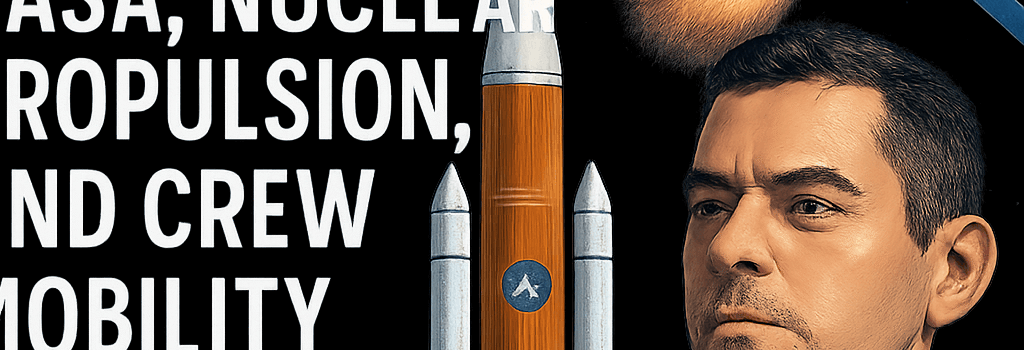Isaacman’s Vision: Agile NASA, Nuclear Propulsion, and Crew Mobility

Reform Agenda Rooted in Organizational Streamlining
Jared Isaacman spent six months deeply embedded in NASA’s operations, identifying the agency’s structural bottlenecks. He criticized the “bloated management layers” that dilute responsibility and slow decision-making across field centers and headquarters. His 100-page modernization blueprint advocated collapsing redundant deputy roles and instituting a lean, mission-first hierarchy.
- Eliminate overlapping principal, deputy, and assistant-to-the-deputy positions
- Institute cross-functional “strike teams” for rapid prototyping
- Adopt industry-standard agile frameworks to shorten approval cycles
Streamlined Leadership and Agile Sprints
Isaacman proposed embedding Scrum and Kanban methodologies into NASA’s engineering divisions. A pilot at Goddard Space Flight Center reportedly cut design review times by 40%, according to internal sources. Weekly sprint reviews and clear “Definition of Done” criteria would replace month-long status meetings.
Accelerating Artemis II: From Pad to Launch in Six Months
The Artemis II mission is currently planned to send four astronauts around the Moon in April 2026. Isaacman’s plan aimed to replicate Apollo 8’s historic December launch by bringing the Space Launch System (SLS) Core Stage to the pad by late summer, targeting a December liftoff.
- Convene multidisciplinary strike teams to debug software and avionics in parallel with structural tests
- Streamline GSDO ground support through dedicated rapid-integration slots at Launch Complex 39B
- Conduct parallel qualification tests on Orion’s European Service Module and heat shield while finalizing crew training
Implementation would require realigning NASA’s FY 2026 budget to front-load funding and secure Congressional buy-in on accelerated milestones.
Revitalizing ISS Utilization with Seven-Crew Dragon
Faced with budget-driven ISS crew cuts, Isaacman advocated for certifying SpaceX Dragon 2 to carry seven astronauts—the capsule’s baseline design capacity. This expansion would boost research opportunities, onboard experiments, and commercial partnerships.
- Upgrade Environmental Control and Life Support System (ECLSS) to handle up to seven crew for 30 days
- Reconfigure cargo racks to accommodate payload specialists alongside professional astronauts
- Negotiate one privately funded mission to offset operational costs and stimulate orbital microgravity research
Nuclear Electric Propulsion: Technical Deep Dive
Principles and System Architecture: Nuclear electric propulsion (NEP) uses a high-temperature fission reactor to generate electricity, which then powers ion or Hall-effect thrusters. NEP systems can achieve specific impulses above 5,000 s, compared with ~450 s for chemical rockets, drastically reducing propellant mass.
“A megawatt-class reactor system mated to a 20-kW Hall thruster could enable round-trip crewed missions to Mars in the mid-2030s,” said Dr. Elena Mazur, nuclear propulsion expert at the Department of Energy.
Key technical challenges include reactor heat rejection (requiring deployable radiator arrays), radiation shielding for crew safety (approximately 20 g/cm² of water-equivalent shielding), and in-space assembly of high-voltage power architecture (≥50 kV). Isaacman’s roadmap called for:
- Deploying a 100 kW test reactor in cislunar space by 2027
- Scaling to a 1 MW human-rated NEP stage within four years
- Leveraging NASA’s Kilopower Reactor Using Stirling Technology (KRUST) and DARPA’s DRACO heritage
Economic and Political Implications
Redirecting SLS budgets toward nuclear orbiter development would sustain jobs in Alabama and Louisiana. Isaacman pitched that a “nuclear orbiter” program—comparable to SLS-scale funding—could preserve regional industrial bases and win critical Senate support.
Deeper Analysis: International Collaboration and Debris Mitigation
Expanding NEP initiatives and crewed cislunar platforms will require coordination with ESA, JAXA, and CSA on reactor licensing, export control (ITAR), and orbital debris mitigation. International technical working groups are already drafting standards for safe proximity operations of high-power reactors abroad.
Future Outlook and Industry Perspectives
Leaders at SpaceX and Blue Origin have expressed support for NEP testbeds, citing potential spin-offs in satellite propulsion and deep-space telescopes. NASA’s FY 2026 budget request includes $450 million for NEP technology maturation, aligning with Isaacman’s recommendations.
Conclusion
Although Jared Isaacman never assumed the administrator role, his comprehensive proposal for agile reforms, seven-crew Dragon certification, and ambitious nuclear propulsion roadmaps continues to influence NASA’s strategic planning. As the agency navigates political headwinds, these ideas offer a blueprint for accelerated lunar return and sustainable exploration of the Solar System.